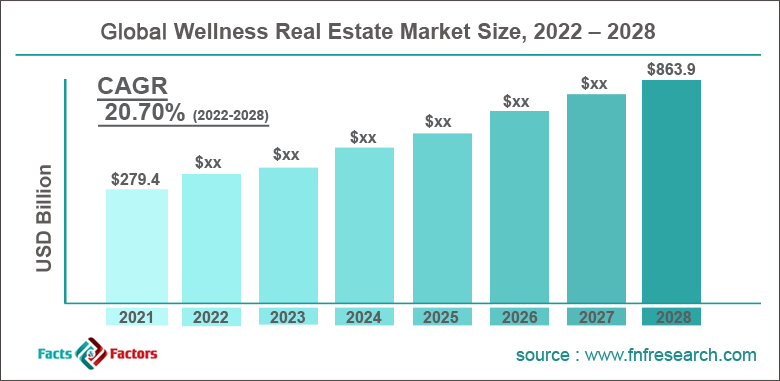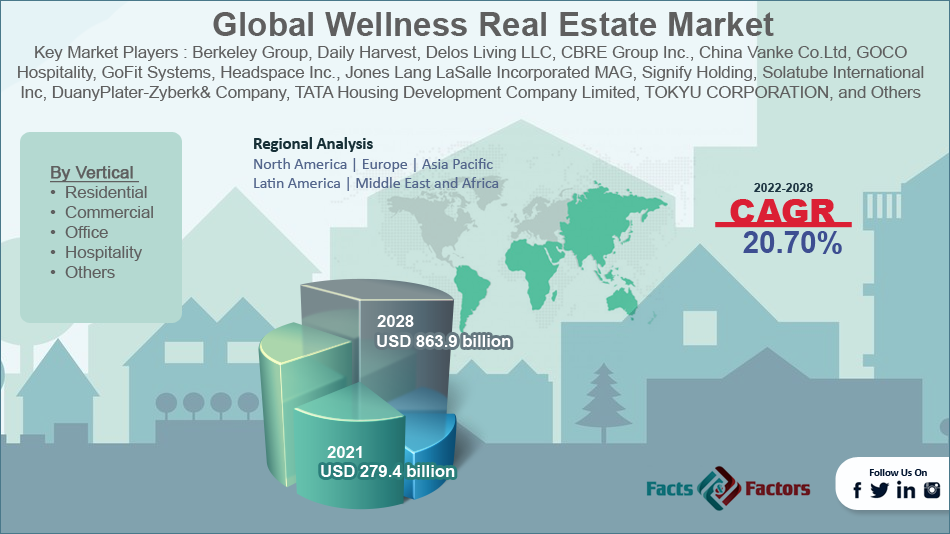Search Market Research Report
Wellness Real Estate Market Size, Share Global Analysis Report, 2022 – 2028

Wellness Real Estate Market Size, Share, Growth Analysis Report By Vertical (Residential, Commercial, Office, Hospitality and Others), and By Region - Global and Regional Industry Insights, Overview, Comprehensive Analysis, Trends, Statistical Research, Market Intelligence, Historical Data and Forecast 2022 – 2028
Industry Insights
[220+ Pages Report] According to Facts and Factors, the global wellness real estate market size was worth around USD 279.4 billion in 2021 and is estimated to grow to about USD 863.9 billion by 2028, with a compound annual growth rate (CAGR) of approximately 20.70% over the forecast period. The report analyzes the Wellness real estate market's drivers, restraints/challenges, and their effect on the demands during the projection period. In addition, the report explores emerging opportunities in the wellness real estate market.

 Market Overview
Market Overview
The expanding wellness real estate market can help address the massive health issues the globe is currently confronting. The main objective of the wellness real estate activities is to prioritize people's wellness when designing, constructing, and redeveloping homes and areas. The movement was not created out of thin air; instead, it borrowed the concept of wellbeing from several historical and modern trends, combining the best elements via a multidimensional wellness lens. Numerous aspects of the culinary, design-driven, and green building movements are already well-known.
New forms of urbanism, intentional communities, and other concepts are already creatively incorporated into upcoming residential projects and communities emphasizing wellbeing. During the projection period, the market in the luxury sector will be driven by a growth in the number of partnerships and associations among suppliers. Over the anticipated timeframe, the development of green organizations worldwide and the beginning of numerous projects that convert existing structures into greener ones will drive the rise of the wellness real estate market.
 COVID-19 Impact:
COVID-19 Impact:
The COVID-19 pandemic has had a detrimental effect on the market expansion. Due to stringent lockdown measures and movement limitations, the pandemic's results were noticeable during the first several months of the crisis, particularly from a retail perspective. Lockdowns were imposed in several areas, which delayed new development projects and slowed industry growth. The industry saw a slow comeback after the COVID-19 epidemic, with excellent sales and the introduction of new initiatives. Since individuals began to realize the advantages of homeownership during the epidemic and began to view it as the safest form of investment, there was a significant spike in sales.
 Key Insights
Key Insights
- As per the analysis shared by our research analyst, the global wellness real estate market value will grow at a CAGR of 20.70% over the forecast period.
- The global healthcare market was valued at around USD 279.4 billion in 2021 and is projected to reach USD 863.9 billion by 2028.
- The market in the luxury sector will be driven by a growth in the number of partnerships and associations among suppliers.
- By vertical, the commercial segment dominated the market in 2021.
- North America dominated the global wellness real estate market in 2021.

 Growth Drivers
Growth Drivers
- The rising demand for wellness real estate is likely to pave the way for global market growth
Developers increasingly include outdoor yoga studios, medicinal gardens filled with relaxing herbs, and meditation courtyards in their residential developments to preserve wellbeing among the affluent housing sectors. Additionally, wealthy homebuyers expect eco-friendly homes constructed with natural materials and interior design components supporting mental clarity. The market for luxury goods will also be driven by an expansion in vendor alliances and partnerships throughout the forecast period. Increased demand for wellness real estate from the luxury residential sector is fueling market expansion.
 Restraints
Restraints
- Lack of awareness regarding healthcare cybersecurity may hamper the global market growth.
The global wellness real estate market is fragmented, with numerous regional and international vendors participating in the industry. As a result, there is now a significant concern of rivalry among providers due to increased market competition. Local and regional vendors have formed partnerships and collaborations in response to the rising competition from foreign merchants, which has heightened rivalry in the industry. Fierce competition from nearby suppliers of other building monitoring and control systems (such as air purifiers and others) restrains the market's expansion. However, constraints like intense rivalry in the wellness real estate market could hinder the market growth.
 Opportunities
Opportunities
- The growing trend of green construction policies will likely pave the way for global market growth.
Over the anticipated timeframe, there will likely be a significant increase in demand for green constructions due to worries about GHG gas emissions from buildings. In addition, the necessity to reduce operating costs and protect the environment will likely motivate builders to create green structures. Over the projected timeframe, these variables are expected to significantly contribute to the wellness real estate industry boom. The potential of green buildings to provide excellent air quality and good biodiversity is linked with the growing popularity of these structures.
 Segmentation Analysis
Segmentation Analysis
The global wellness real estate market is segregated based on vertical and region.
By vertical, the market is divided into residential, commercial, office, hospitality and others. Over the forecast period, the commercial segment is expected to develop fastest in 2021. The commercial segment's wellness real estate market share will expand significantly during the forecast period. Commercial real estate, offices and workspaces, public buildings, hospitality developments, and medical facilities comprise the commercial component. The number of commercial wellness real estate developments in the Middle East, Asia Pacific, and South America has increased in recent years. Furthermore, rising emphasis on corporate health and demand for green and sustainable buildings will likely drive the market throughout the forecast period.
 Report Scope
Report Scope
Report Attribute |
Details |
Market Size in 2021 |
USD 279.4 Billion |
Projected Market Size in 2028 |
USD 863.9 Billion |
CAGR Growth Rate |
20.70% CAGR |
Base Year |
2021 |
Forecast Years |
2022-2028 |
Key Market Players |
Berkeley Group, Daily Harvest, Delos Living LLC, CBRE Group Inc., China Vanke Co.Ltd, GOCO Hospitality, GoFit Systems, Headspace Inc., Jones Lang LaSalle Incorporated MAG, Signify Holding, Solatube International Inc, DuanyPlater-Zyberk& Company, TATA Housing Development Company Limited, TOKYU CORPORATION, and Others |
Key Segment |
By Vertical, and Region |
Major Regions Covered |
North America, Europe, Asia Pacific, Latin America, and the Middle East & Africa |
Purchase Options |
Request customized purchase options to meet your research needs. Explore purchase options |
 Regional Landscape
Regional Landscape
- The rising demand for premium wellness real estate is likely to help North America dominate the global market
North America dominated the wellness real estate market in 2021. North America will account for 38% of market growth. In North America, the U.S. is an important market for wellness real estate. Over the projected period, the development of the wellness real estate market in North America will be aided by the rising demand for premium wellness real estate and the rising number of wellness real estate commercial and residential projects. The increase in wellness initiatives and the rising demand for wellness programs in the area are responsible for the regional market's expansion. The region with the most wellness lifestyle real estate developments in North America, with 372 projects, followed by 293 in the Asia Pacific.
 Competitive Landscape
Competitive Landscape
Key players within the global Wellness Real Estate market include
- Berkeley Group
- Daily Harvest
- Delos Living LLC
- CBRE Group Inc.
- China Vanke Co.Ltd
- GOCO Hospitality
- GoFit Systems
- Headspace Inc.
- Jones Lang LaSalle Incorporated MAG
- Signify Holding
- Solatube International Inc
- DuanyPlater-Zyberk& Company
- TATA Housing Development Company Limited
- TOKYU CORPORATION
The global wellness real estate market is segmented as follows:
 By Vertical
By Vertical
- Residential
- Commercial
- Office
- Hospitality
- Others
 By Region
By Region
-
North America
- The U.S.
- Canada
- Mexico
- Europe
- France
- The UK
- Spain
- Germany
- Italy
- Nordic Countries
- Denmark
- Sweden
- Norway
- Benelux Union
- Belgium
- The Netherlands
- Luxembourg
- Rest of Europe
- Asia Pacific
- China
- Japan
- India
- Australia
- South Korea
- Southeast Asia
- Indonesia
- Thailand
- Malaysia
- Singapore
- Rest of Southeast Asia
- Rest of Asia Pacific
- The Middle East & Africa
- Saudi Arabia
- UAE
- Egypt
- South Africa
- Rest of the Middle East & Africa
- Latin America
- Brazil
- Argentina
- Rest of Latin America
Industry Major Market Players
- Berkeley Group
- Daily Harvest
- Delos Living LLC
- CBRE Group Inc.
- China Vanke Co.Ltd
- GOCO Hospitality
- GoFit Systems
- Headspace Inc.
- Jones Lang LaSalle Incorporated MAG
- Signify Holding
- Solatube International Inc
- DuanyPlater-Zyberk& Company
- TATA Housing Development Company Limited
- TOKYU CORPORATION
Frequently Asked Questions

Copyright © 2024 - 2025, All Rights Reserved, Facts and Factors


